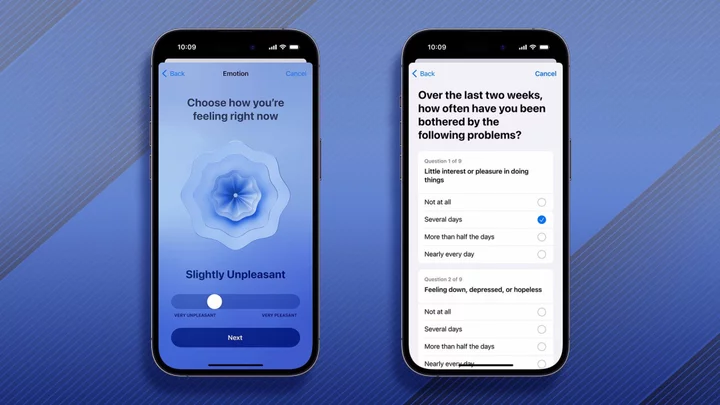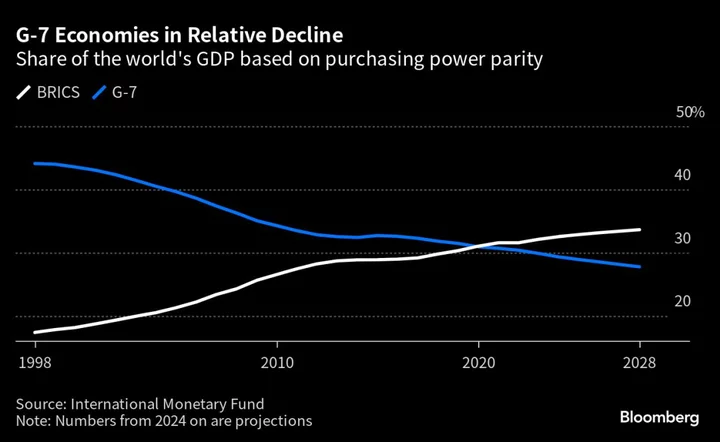There's no shortage of digital mood and mental health trackers. Typically packaged into an app easily accessed on a digital device, these logs or journals are designed to help users identify patterns in their emotional state and well-being.
Now the category has a new contender in Apple Health's Mental Wellbeing features.
The features offer the option to log a momentary emotion or daily mood. They debuted as part of Apple's latest software updates iOS 17, iPadOS 17, and watchOS 10, which launched earlier in September.
Additionally, Mental Wellbeing provides easy access to two clinically-validated self-assessments for anxiety and depression. Users can then share those assessment results with a physician or trusted medical professional for a follow-up conversation.
All of the information you input, in both the logging and assessment tools, is encrypted on-device and only accessible with your passcode, Touch ID, or Face ID. When syncing health data to iCloud with the default two-factor authentication and a passcode, your health data is encrypted end-to-end. In other words, no one can read it, including Apple.
SEE ALSO: Apple iPhone 15 and 15 Plus review: Almost ProHere's how to use Apple Health's Mental Wellbeing feature:
Where to find Mental Wellbeing
Mental Wellbeing lives in Apple Health on the iPhone and iPad and via the Mindfulness App in Apple Watch.
On an iPhone or iPad, it's easiest to find by opening Apple Health and clicking browse. You'll find a list of health categories, including Mental Wellbeing.
Tap that option, then select State of Mind. On the next screen, click the "get started" button if this is your first time using the feature, or the "log" button or calendar icon in the upper right hand corner if you've done it before.
For more Social Good stories in your inbox, sign up for Mashable's Top Stories newsletter today.
You can also set a daily, twice daily, or additional reminder to log a mood or emotion by scrolling all the way down the State of Mind section and clicking on "options." From there, you can choose to be reminded to create a new log during your day, at the end of your day, and/or at a specific time of day. That menu also includes an option to manage logging notifications in Apple Watch.
To find the logging feature on Apple Watch, click the Mindfulness App. If you have watchOS 10, the logging option will be available in that menu.
How to log a mood or emotion
Before you log anything, Apple Health has made an important distinction between an emotion or mood, which may change what you track, and how.
In an explanatory article about the difference between emotion and mood within the Mental Wellbeing feature, Apple Health notes that an emotion is a momentary reaction to a specific experience, while a mood lasts longer, can stem from multiple factors, and may have no clear cause.
When you select the "log" button or calendar icon in State of Mind, you'll be able to start the logging process. When prompted to "log," select emotion or mood. Choose what makes most sense for you, based on the day's events, or what you'd most like to analyze for trends. You can also choose to separately log both an emotion and a mood.
A new parent, for example, might want to log both emotion and mood to track feelings that arise in response to stressful or joyful parenting experiences in addition to better understanding their overall mood over time as they adjust to becoming a parent.
Apple Health's Mental Wellbeing emotion and mood logging feature helps track your mental health. Credit: AppleLogging just an emotion could be useful for someone looking to pinpoint experiences that boost or worsen their well-being, like time spent on social media, hobbies, or physical activity.
Regardless of what you choose, you'll then be prompted to gauge the nature of your mood or emotion on a scale from "very unpleasant" to "very pleasant."
Click next to select from more than three dozen adjectives that best describe your feeling, including "calm," "angry," "drained," "indifferent," "jealous," "joyful," and "proud."
Lastly, you'll be prompted to note what's having the biggest "impact" on you. Pre-written factors you can choose from include health, spirituality, family, tasks, weather, money, and current events. If you select one or more of those options, you can add additional context in a text box below. On an Apple Watch, type or use dictation if you wish to complete the text box.
You can also go back in time via the calendar icon and log emotions or moods that occurred in the past.
How to get insights from your mood and emotion logging
If a clear association emerges from your logging, you may receive a highlight offering additional insights from Apple Health. These are generated by software, so Apple employees are not viewing and analyzing your data.
However, without enough data to analyze, it's unlikely Apple Health will spot patterns.
That's one reason to consider using the feature regularly. The other benefit is that more data means you can personally evaluate the logged emotions and moods for connections to lifestyle factors, for example.
Apple Health can now help you track insights related to your mental health. Credit: AppleIn order to review your data, go to the main State of Mind section and click on "show in charts." There you'll be able to view logged moods and emotions plotted out on an interactive chart by week, month, six months, and annually. The x-axis is time frame and the y-axis is the range of very unpleasant to very pleasant.
Below the chart are three ways to organize the data: states, as in moods and emotions; associations, as in factors like community, dating, and education; and life factors.
The last category includes objective data measured by Apple Watch or stored by Apple Health, which are exercise minutes, mindful minutes, sleep, and time in daylight. You can compare those measurements against your logged emotions or moods as a way of detecting an association between, say, a good night's rest and a very pleasant mood.
How to take a depression or anxiety assessment
Apple Health is programmed to send users a biannual reminder to consider taking a depression or anxiety self-assessment.
These assessments, the Patient Health Questionnaire (PHQ-9) and the Generalized Anxiety Disorder-7 (GAD-7), are short questionnaires widely used in healthcare settings to determine someone's risk for depression and anxiety, respectively. If you feel like taking one or both assessments, they are available in State of Mind by selecting either "anxiety risk" or "depression risk."
Apple Health Mental Wellbeing self-assessment One Mental Wellbeing feature is access to clinically-validated mental health assessments. Credit: Apple Mental Wellbeing self-assessment results Self-assessment results can be shared with a trusted medical or mental health professional. Credit: AppleFurther down the page you'll find a box called "mental health questionnaires," which explains why you might take the questionnaires, what the results mean, and when to talk to a doctor. Additionally, there is contact information for the 988 Suicide and Crisis Lifeline as well as the National Alliance on Mental Illness.
If you log numerous "unpleasant" moods and emotions for a period of time, Apple Health will prompt you to take the assessments, independent of its biannual reminder.
The results of both self-assessments can be saved as a PDF, then shared with a healthcare professional you trust.
How to keep your logged emotions and assessment results secure
All data logged in Apple Health is encrypted on your device and when it's synced to other devices. Your logs and assessment results will never be shared with a third party, unless you specifically choose to do so via screenshot, PDF, or other means, like the Health Sharing feature, according to Apple.
Apple emphasizes the importance of securing your data by using two-factor authentication as well as a passcode, Touch ID, or Face ID to ensure your data remains unreadable to anyone else. That is what makes your data unreadable to anyone else.
If you're feeling suicidal or experiencing a mental health crisis, please talk to somebody. You can reach the 988 Suicide and Crisis Lifeline at 988; the Trans Lifeline at 877-565-8860; or the Trevor Project at 866-488-7386. Text "START" to Crisis Text Line at 741-741. Contact the NAMI HelpLine at 1-800-950-NAMI, Monday through Friday from 10:00 a.m. – 10:00 p.m. ET, or email info@nami.org. If you don't like the phone, consider using the 988 Suicide and Crisis Lifeline Chat at crisischat.org. Here is a list of international resources.









